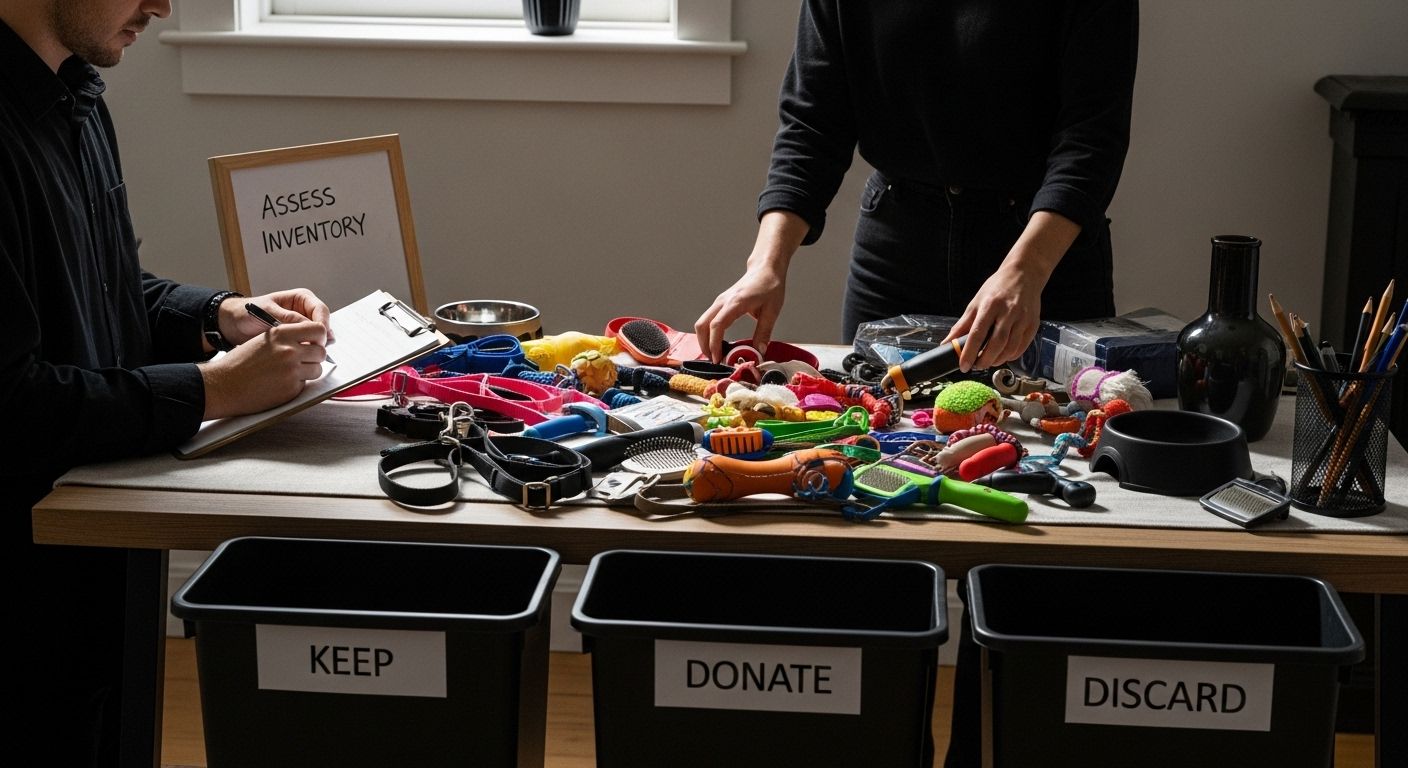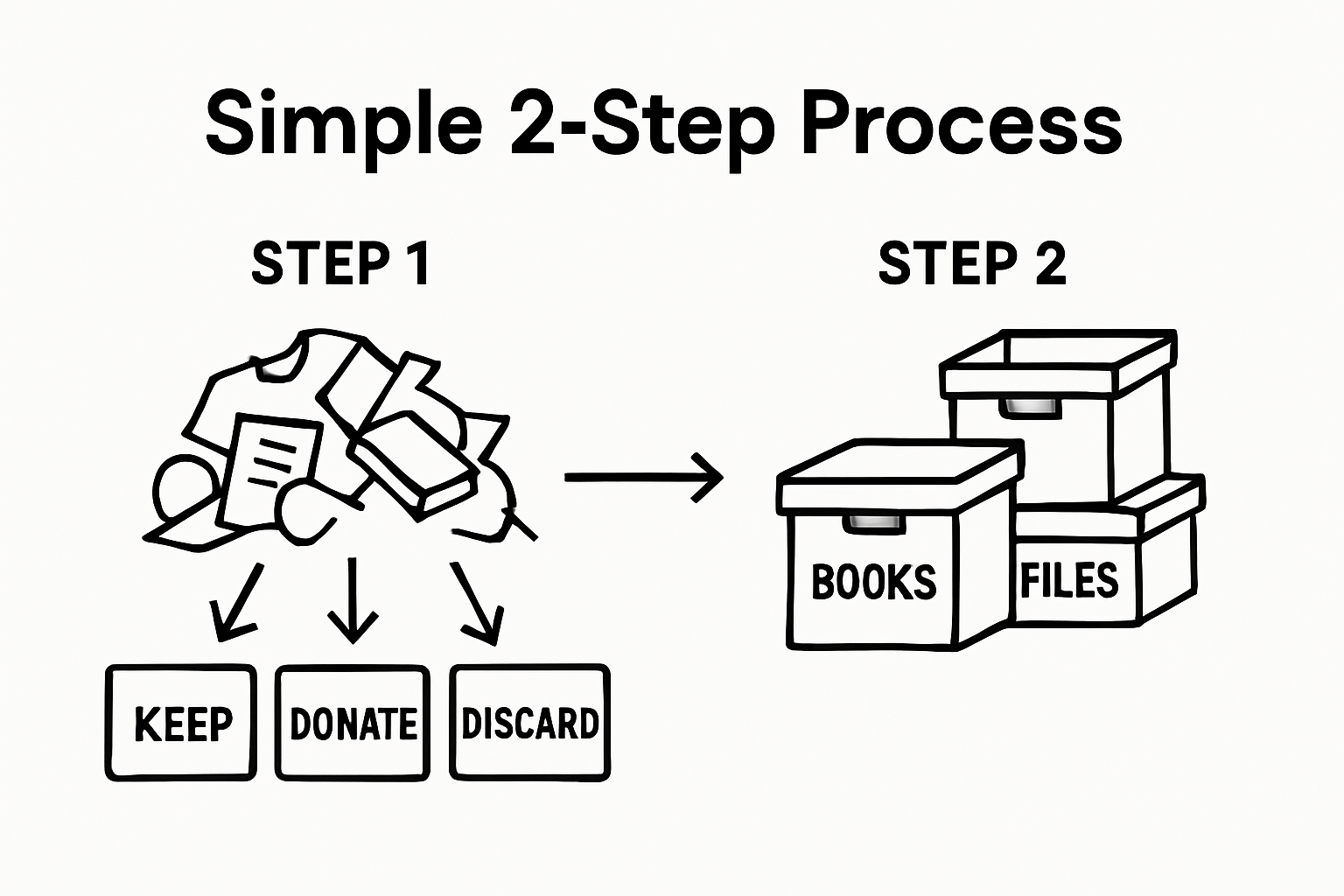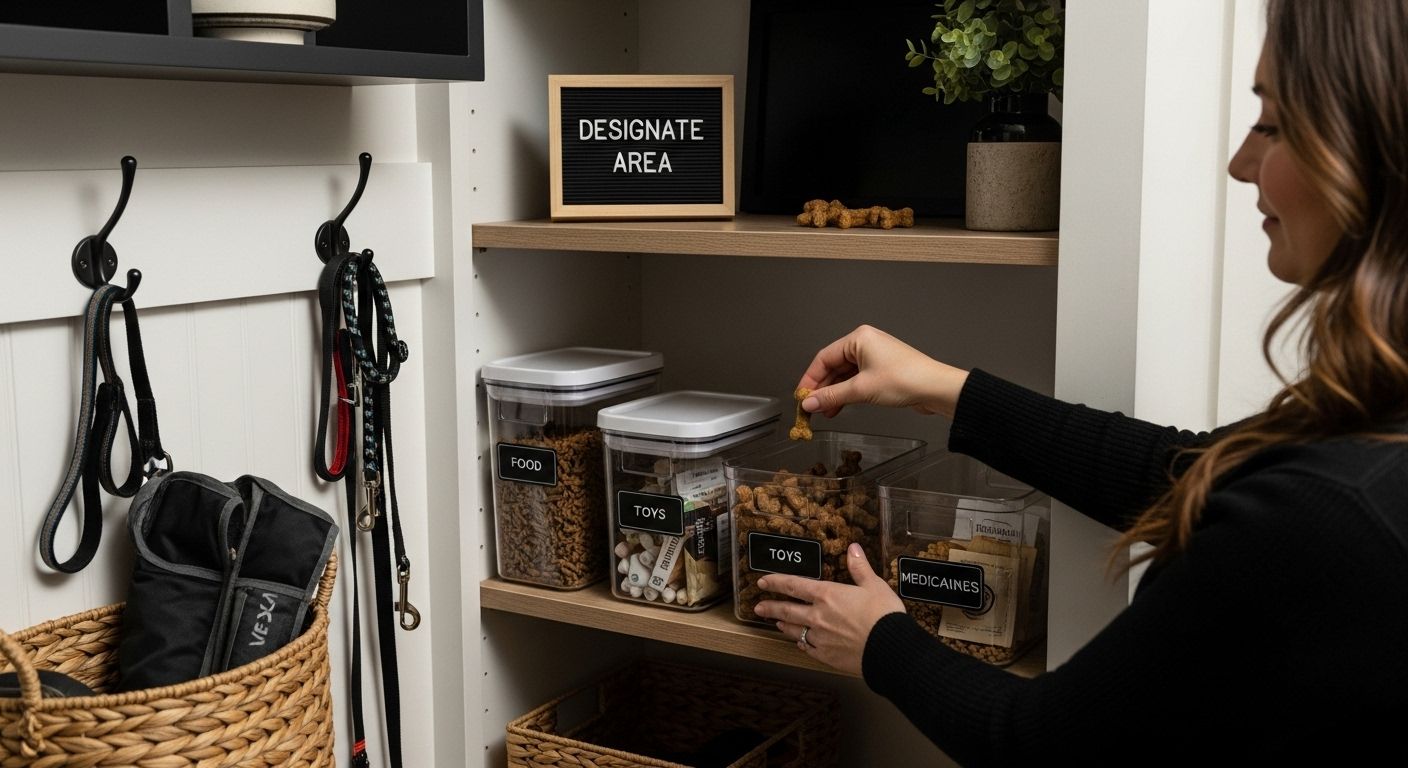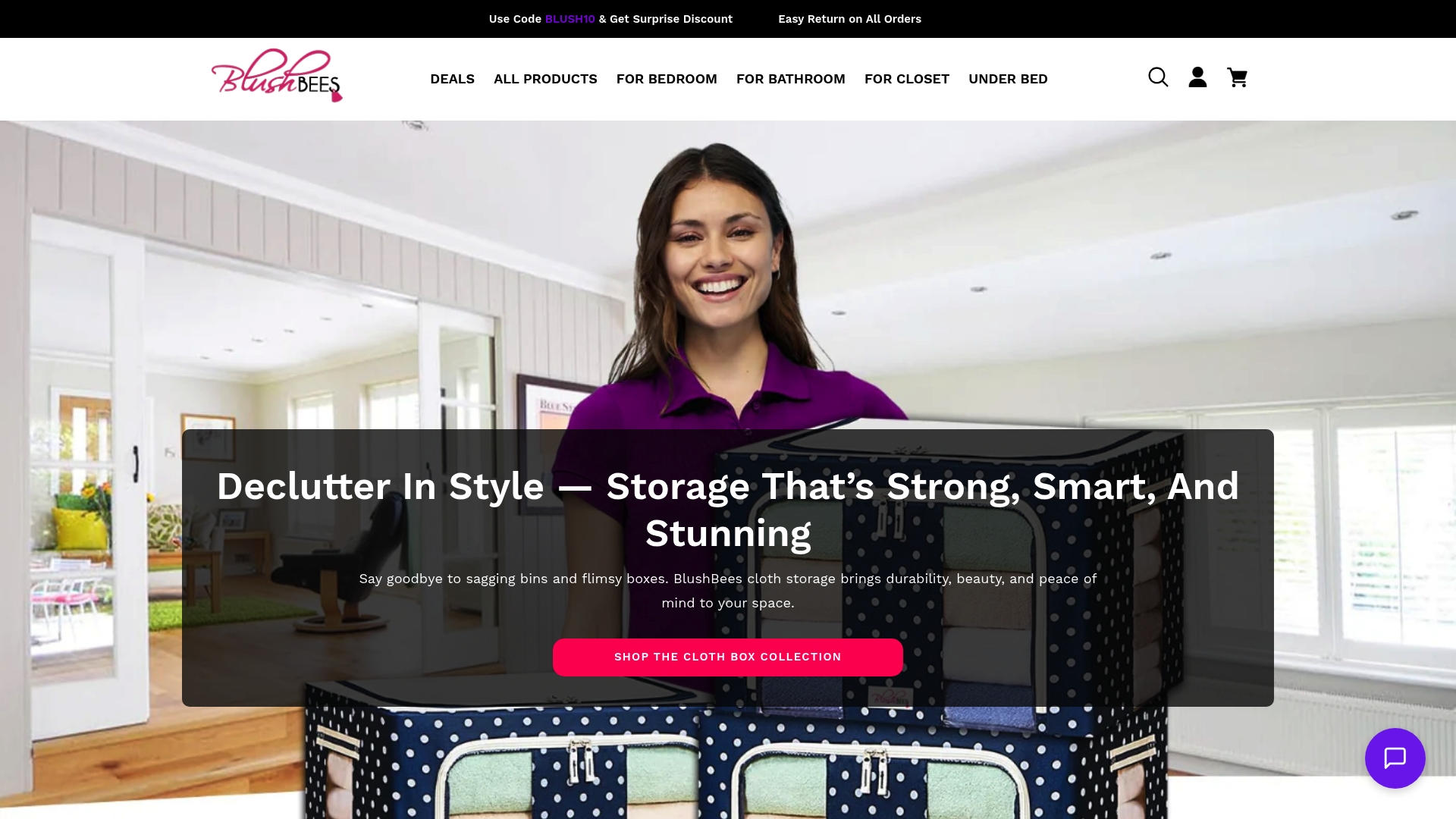

Pet supplies tend to pile up fast and pretty soon you might have leashes in the closet, treats in the pantry, and grooming tools hiding everywhere. Most people discover dozens of expired meds and duplicate toys when they finally gather everything in one place. Surprising right? Yet buying fancy containers is actually the wrong first step. The real trick is starting with a full inventory check and a system that actually sticks long term.
Table of Contents
- Step 1: Assess Your Current Pet Supply Inventory
- Step 2: Categorize Your Supplies By Type And Usage
- Step 3: Choose Stylish Storage Solutions
- Step 4: Designate A Specific Area For Pet Supplies
- Step 5: Implement An Easy-To-Maintain System
- Step 6: Verify And Adjust Your Organization System
Quick Summary
| Key Point | Explanation |
|---|---|
| 1. Conduct a thorough inventory | Collect all pet supplies and evaluate their condition before organizing to identify duplicates and unnecessary items. |
| 2. Create clear categories for organization | Establish main and subcategories based on pet needs and supply frequency to streamline access to items. |
| 3. Choose functional and aesthetic storage | Select stylish, clear containers that protect supplies and complement your home while maximizing space efficiency. |
| 4. Designate a specific, accessible area | Identify a practical location for pet supplies that integrates well with daily routines and provides easy access. |
| 5. Implement an easy maintenance system | Develop a labeling and tracking method, paired with a maintenance routine, to keep your organization system functional long-term. |
Step 1: Assess Your Current Pet Supply Inventory
Organizing pet supplies begins with a comprehensive inventory assessment that sets the foundation for a streamlined and efficient storage system. Before diving into containers and storage solutions, you need to understand exactly what pet supplies you currently own, their condition, and how they are being used.
Start by gathering all your pet supplies from every corner of your home. Pull items from kitchen cabinets, bathroom shelves, closets, garage storage, and any other spaces where pet-related items might be scattered. Spread everything out on a large, clean surface where you can see each item clearly. This visual inventory helps you recognize how many duplicate or unnecessary items you might have accumulated over time.
As you collect supplies, create three initial sorting categories: keep, donate, and discard. Pet supplies that are expired, damaged, or no longer appropriate for your pet’s current needs should be carefully evaluated. Medications with past expiration dates, worn-out toys, or items that no longer fit your pet’s size or health requirements belong in the discard pile. Gently used items in good condition can be donated to local animal shelters or rescue organizations.
Learn more about pet supply organization by understanding how systematic inventory management can transform your pet care routine. During this assessment, pay special attention to frequently used items like food, medications, grooming tools, and accessories. Categorize these items by type and frequency of use. This initial sorting will help you design a storage system that prioritizes accessibility and efficiency.
To verify you have completed this step successfully, ensure you have:
- Collected all pet-related items from every location
- Created clear sorting categories
- Identified and separated items to keep, donate, or discard
- Documented the types and quantities of supplies you own
A thorough inventory assessment transforms chaotic pet supply storage into an organized, purposeful system that saves time, reduces waste, and makes pet care more enjoyable.

Step 2: Categorize Your Supplies by Type and Usage
After your initial inventory assessment, the next critical step in organizing pet supplies is creating a systematic categorization strategy that transforms scattered items into a functional storage solution. Effective categorization goes beyond simply grouping similar items it creates an intuitive system that makes accessing and maintaining your pet supplies effortless.
Begin by establishing primary categories that reflect your pet’s specific needs. Core categories typically include feeding supplies, grooming tools, health and medication, toys and enrichment items, travel and outdoor gear, and training accessories. Within each category, create subcategories that provide even more granular organization. For feeding supplies, this might mean separating dry food, wet food, treats, food bowls, and feeding accessories into distinct groups.
Explore smart organization techniques that can help you develop a robust categorization system tailored to your specific pet care requirements. Consider your pet’s lifestyle and unique needs when designing these categories. A dog who goes hiking might need a more extensive outdoor gear section, while an indoor cat might require more elaborate toy and enrichment categories.
Frequency of use is another crucial factor in categorization. Arrange items based on how often they are used, placing frequently accessed supplies in easily reachable locations. Medications, daily grooming tools, and regular feeding supplies should be front and center, while seasonal or occasional items can be stored in less prime storage spaces. This approach ensures that your most essential pet care items are always within quick reach.
To verify you have successfully completed this categorization step, confirm you have:
- Created comprehensive categories reflecting your pet’s specific needs
- Developed subcategories within each main category
- Organized items based on frequency of use
- Established a logical and intuitive storage system
A well-designed categorization system not only makes finding supplies easier but also helps you maintain a cleaner, more organized pet care environment.
Step 3: Choose Stylish Storage Solutions
Selecting the right storage solutions transforms your pet supply organization from functional to fabulous, creating a space that looks as good as it works. The key is finding containers and systems that not only protect and organize your supplies but also complement your home’s aesthetic and meet your specific organizational needs.
Prioritize clear, stackable containers that allow you to see contents at a glance while maximizing vertical storage space. Look for containers with secure, airtight lids to keep pet food fresh and protect against moisture and pests. Consider modular storage systems that can be easily reconfigured as your pet’s needs change. Lightweight, durable plastic bins with labeled compartments work exceptionally well for storing everything from medications to grooming tools. Color coordination can be a game changer, allowing you to create a visually appealing storage system that feels intentional and organized.
Discover innovative storage strategies that can help you maximize every inch of available space. When selecting storage solutions, think beyond traditional containers. Wall-mounted shelves, over-the-door organizers, and under-furniture storage can provide creative ways to keep pet supplies accessible yet out of sight. For smaller items like medications, treats, and accessories, consider drawer dividers or small compartmentalized boxes that keep everything neatly separated and easy to find.
Consider the specific materials and design of your storage solutions. Look for options that are easy to clean, resistant to moisture, and capable of withstanding the wear and tear of pet-related items. Fabric storage cubes with removable liners, metal wire baskets with powder-coated finishes, and clear acrylic containers can all provide both functionality and style. The goal is to create a storage system that feels like a seamless part of your home decor.
To verify you have successfully chosen your storage solutions, confirm you have:
- Selected containers that are functional and visually appealing
- Ensured storage solutions protect and preserve pet supplies
- Created a system that is easily accessible and adaptable
- Chosen materials that complement your home’s aesthetic
The right storage solutions turn pet supply organization from a chore into a design opportunity, making your space both practical and beautiful.
Step 4: Designate a Specific Area for Pet Supplies
Designating a specific area for pet supplies transforms your organization strategy from scattered to strategic, creating a dedicated space that keeps everything accessible and tidy. The ideal location combines convenience with practicality, considering your pet’s daily routines and your home’s layout. Consider proximity to feeding areas, entry points, and spaces where your pet spends most of their time.
Start by evaluating potential spaces that can accommodate your pet supply storage needs. Mudrooms, utility rooms, kitchen corners, and hallway closets often make excellent dedicated storage zones. Multi-functional furniture can be a game changer, such as console tables with built-in storage, benches with hidden compartments, or wall-mounted shelving units that keep supplies off the floor while adding a decorative element to your home. Look for areas that are dry, temperature-controlled, and away from direct sunlight to preserve the quality of pet food and medications.
Discover innovative home organization techniques that can help you create a seamless storage solution. When selecting your dedicated pet supply area, consider vertical storage options that maximize space efficiency. Install adjustable shelves, use over-the-door organizers, or incorporate pull-out drawers that make every inch of space count. For smaller homes or apartments, creative solutions like under-furniture storage or wall-mounted systems can provide ample room without sacrificing living space.
Consider your pet’s specific needs when designing the storage area. A dog with multiple walking accessories will require different storage solutions compared to an indoor cat with minimal gear. Create zones within your designated area for different supply categories like grooming tools, medications, treats, and toys. Use clear labels or color-coded containers to make finding items quick and effortless.
To verify you have successfully designated a pet supply area, confirm you have:
- Selected a convenient and practical storage location
- Ensured the area protects supplies from environmental damage
- Created organized zones for different supply categories
- Integrated storage solutions that complement your home’s design
A well-planned pet supply area not only keeps your home organized but also makes pet care more efficient and enjoyable.

Step 5: Implement an Easy-to-Maintain System
Creating an easy-to-maintain system is the final critical step in transforming your pet supply organization from a one-time project to a sustainable routine. The key is developing a system so intuitive that maintaining it becomes second nature, requiring minimal effort and thought to keep everything in its designated place.
Start by establishing clear labeling protocols that make identifying and returning items effortless. Use a consistent labeling method across all containers, preferably with bold, clear text that can be read at a glance. Consider color-coding systems that match different categories of pet supplies such as green for grooming items, blue for medications, and red for toys. Digital inventory tracking can be a game changer, allowing you to monitor supply levels, expiration dates, and restocking needs with minimal manual effort. Smartphone apps or simple spreadsheet templates can help you track everything from medication schedules to food inventory.
Explore smart organization strategies that can streamline your pet supply management. Create a monthly maintenance routine that becomes as regular as feeding your pet. Schedule a brief 15-minute check-in where you review your supplies, reorganize any misplaced items, check expiration dates, and restock as needed. This proactive approach prevents clutter from accumulating and ensures your carefully designed organization system remains functional.
Consider implementing a replacement and restocking protocol that prevents last-minute supply emergencies. Set up automatic reminders on your phone or calendar for replacing critical items like medications, replacing worn-out toys, or restocking food before you run out. Place a small notepad or digital checklist near your pet supply area where family members can quickly note when supplies are running low, creating a collaborative approach to maintaining your organizational system.
To verify you have successfully implemented an easy-to-maintain system, confirm you have:
- Created a consistent labeling system
- Established a regular maintenance routine
- Set up digital or physical tracking methods
- Developed a collaborative restocking strategy
An effective maintenance system turns organization from a chore into a seamless part of your pet care routine.
Step 6: Verify and Adjust Your Organization System
Verifying and adjusting your pet supply organization system is a crucial final step that transforms your initial efforts into a long-term, sustainable solution. Continuous improvement is the cornerstone of maintaining an efficient organizational strategy, requiring periodic assessment and willingness to make necessary modifications.
Begin by living with your new organization system for several weeks, carefully observing how it functions in real-world scenarios. Pay attention to friction points where accessing supplies becomes challenging or where items consistently end up in the wrong locations. Document these challenges by keeping a small notebook or digital note on your phone, tracking moments when the system feels less than optimal. These real-world observations will become your roadmap for refinement, helping you understand exactly where adjustments are needed.
Explore refined organization techniques that can help you fine-tune your pet supply management. Consider involving other household members in the evaluation process. Their perspectives might reveal usability issues you haven’t noticed. Schedule a brief monthly review where everyone who interacts with pet supplies can provide feedback, suggesting potential improvements or identifying recurring organizational challenges.
Adapt your system with flexibility and pragmatism. If certain containers are consistently underused or specific areas remain cluttered, be prepared to reimagine your original layout. This might mean repositioning shelves, switching to different storage containers, or creating entirely new zones for pet supplies. Remember that the most effective organizational system is one that naturally aligns with your household’s unique rhythms and routines.
To verify you have successfully evaluated and adjusted your organization system, confirm you have:
- Documented system performance over multiple weeks
- Collected feedback from household members
- Identified and addressed specific organizational challenges
- Made intentional, strategic adjustments to improve functionality
A truly effective pet supply organization system is never static but evolves continuously to meet your changing needs.
Below is a checklist table summarizing how to verify each step in the pet supply organization process. Use it to track your progress and ensure nothing is missed.
| Step | Verification Checklist | Outcome |
|---|---|---|
| Assess Inventory | All pet items collected; items sorted into keep, donate, discard; quantities documented | Accurate inventory established |
| Categorize Supplies | Categories and subcategories created; items organized by type and use frequency | Logical organization system set up |
| Select Storage | Functional, stylish containers chosen; storage is accessible and complements home | Supplies protected and organized |
| Designate Area | Storage location chosen; zones set up for each supply type; area suits pet needs | Dedicated space for pet items |
| Maintenance System | Consistent labeling in place; routine and restocking protocol established | Organization easy to sustain |
| Verify & Adjust | System monitored for weeks; issues and feedback documented; improvements made | Long-term system effectiveness |
Transform Pet Supply Chaos into Organized Harmony
Are you tired of pet toys, leashes, and grooming items overflowing in every corner of your home? The article on organizing pet supplies highlights that clutter and confusion can steal both your space and precious time. The real pain point is not having a stylish, functional storage system that fits seamlessly into your lifestyle. Imagine the relief of finding everything you need instantly with a space that looks great and stays tidy every day. Discover elegant storage bins, stackable containers, and versatile baskets from the Bedroom Storage collection, perfect for corralling every pet item. If you want a special deal to jump-start your organization journey, be sure to check out our Deal Of The Week for time-limited discounts.

Create the organized, efficient space you and your pets deserve now. Browse BlushBees USA and bring home durable, beautiful solutions that turn clutter into calm. Do not wait until the mess returns—upgrade your pet supply storage today and enjoy a tidier tomorrow.
Frequently Asked Questions
How should I assess my pet supply inventory before organizing?
Begin by gathering all pet supplies from various locations in your home. Sort these items into three categories: keep, donate, and discard. Pay special attention to expired or damaged items, and document the types and quantities of supplies you own to create a clear overview.
What are some effective categorization strategies for pet supplies?
Establish primary categories based on your pet’s needs, such as feeding supplies, grooming tools, and toys. Within each category, create subcategories for more granular organization. Arrange items based on how frequently they are used, ensuring that essentials are easily accessible.
What types of storage solutions are best for organizing pet supplies?
Clear, stackable containers with secure lids are ideal for keeping pet food fresh. Additionally, consider modular storage systems and multi-functional furniture. Look for materials that are easy to clean, resistant to moisture, and suitable for the wear and tear of pet supplies.
How can I create an easy-to-maintain pet supply organization system?
Implement a consistent labeling system for all storage containers and establish a regular maintenance routine, such as a monthly check-in to assess supplies. Use digital tracking methods like apps or spreadsheets to monitor inventory levels and set reminders for restocking essential items.



